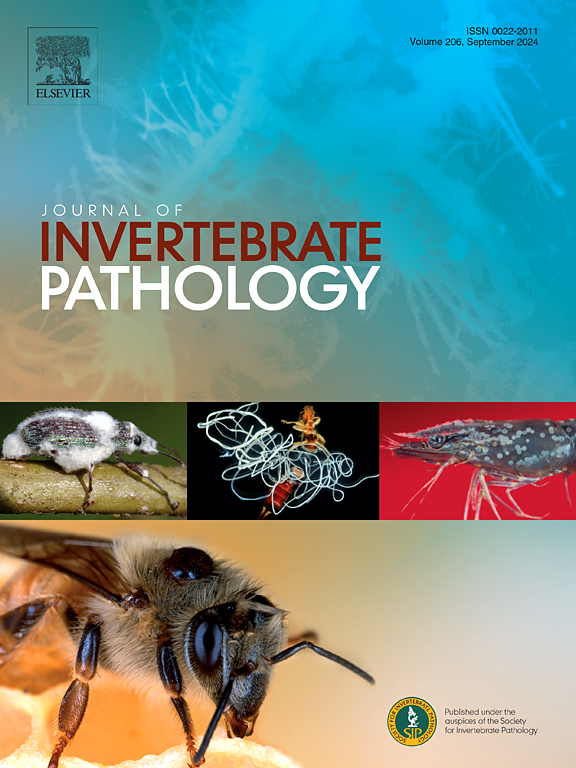采用个体区隔系统有效管理砂蟹Scylla serrata (Forskal, 1775)培养的泥蟹呼肠孤病毒(MCRV)感染
IF 2.4
3区 生物学
Q1 ZOOLOGY
引用次数: 0
摘要
泥蟹(Scylla serrata)水产养殖是印度沿海经济和出口市场的重要贡献者。然而,该部门面临来自泥蟹呼肠孤病毒(MCRV)的重大挑战,这是一种据报造成大规模死亡和严重经济损失的高致病性病毒。本研究评估了不同饲养系统(开放式笼、笼中笼和外部笼)的性能,重点关注其在控制MCRV传播、死亡率和生产结果方面的效果。打开笔系统表现出最高的死亡率(73±4.57%)和MCRV感染率(89.04±3.04%),主要是由于直接接触和同类相食的行为在螃蟹,这促进了病毒的传播。相比之下,笼中笼和外笼系统通过对个体进行物理隔离,显著降低了死亡率(分别为18±2.21%和19.1±2.88%)和MCRV患病率(分别为64.13±4.35%和65.21±3.78%)。与开放式系统(3.5±0.2 kg)相比,这些系统的产量更高(11.2±1.5 kg和10.8±1.8 kg)。组织病理学和透射电镜(TEM)分析证实了MCRV感染,在感染螃蟹的肝胰腺、鳃和肌肉组织中观察到细胞质嗜碱性和嗜酸性包涵体。透射电镜显示二十面体病毒颗粒(~ 70 nm)集中在结缔组织细胞的细胞质中,验证了先前关于MCRV复制的发现。该研究强调了个体隔离系统(如网箱养殖)在减轻MCRV传播和提高泥蟹存活率和生产力方面的关键作用。虽然网箱养殖提供了直接的解决方案,但加强疾病监测、选择性育种计划和生物安全措施等长期战略对于可持续的泥蟹水产养殖至关重要。这些发现为农民和决策者提供了可操作的见解,以加强泥蟹养殖对MCRV暴发的抵御能力。本文章由计算机程序翻译,如有差异,请以英文原文为准。

Effective management of Mud crab Reovirus (MCRV) infection in mud crab, Scylla serrata (Forskal, 1775) culture, using an individual compartmentalized system
Mud crab (Scylla serrata) aquaculture is a critical contributor to coastal economies and export markets in India. However, the sector faces significant challenges from Mud Crab Reovirus (MCRV), a highly pathogenic virus reported to cause mass mortalities and severe economic losses. This study assessed the performance of different rearing systems—open pen, cage-in-pen, and external cage systems—focusing on their efficacy in managing MCRV transmission, mortality, and production outcomes.
The open pen system exhibited the highest mortality rate (73 ± 4.57 %) and MCRV infection rate (89.04 ± 3.04 %), primarily due to direct contact and cannibalistic behavior among crabs, which facilitated viral transmission. In contrast, the cage-in-pen and external cage systems significantly reduced mortality (18 ± 2.21 % and 19.1 ± 2.88 %, respectively) and MCRV prevalence (64.13 ± 4.35 % and 65.21 ± 3.78 %, respectively) by physically isolating individuals. These systems achieved higher production yields (11.2 ± 1.5 kg and 10.8 ± 1.8 kg) compared to the open pen system (3.5 ± 0.2 kg). Histopathological and transmission electron microscopy (TEM) analyses confirmed MCRV infection, with cytoplasmic basophilic and eosinophilic inclusions observed in the hepatopancreas, gills, and muscle tissues of infected crabs. TEM revealed icosahedral viral particles (∼70 nm) concentrated in the cytoplasm of connective tissue cells, validating previous findings on MCRV replication.
This study highlights the critical role of individual compartmentalized systems, such as cage culture, in mitigating MCRV transmission and improving mud crab survival and productivity. While cage culture offers an immediate solution, long-term strategies like enhanced disease surveillance, selective breeding programs, and biosecurity measures are essential for sustainable mud crab aquaculture. These findings provide actionable insights for farmers and policymakers to strengthen the resilience of mud crab farming against MCRV outbreaks.
求助全文
通过发布文献求助,成功后即可免费获取论文全文。
去求助
来源期刊
CiteScore
6.10
自引率
5.90%
发文量
94
审稿时长
1 months
期刊介绍:
The Journal of Invertebrate Pathology presents original research articles and notes on the induction and pathogenesis of diseases of invertebrates, including the suppression of diseases in beneficial species, and the use of diseases in controlling undesirable species. In addition, the journal publishes the results of physiological, morphological, genetic, immunological and ecological studies as related to the etiologic agents of diseases of invertebrates.
The Journal of Invertebrate Pathology is the adopted journal of the Society for Invertebrate Pathology, and is available to SIP members at a special reduced price.

 求助内容:
求助内容: 应助结果提醒方式:
应助结果提醒方式:


